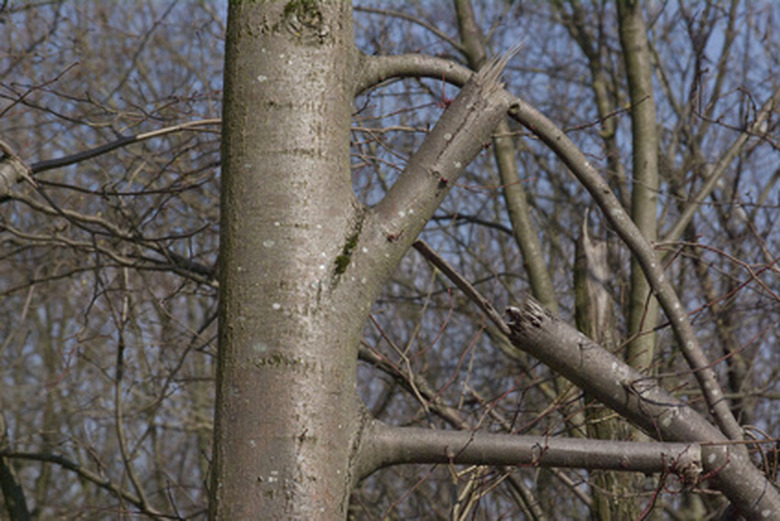How To Brace A Tree Limb With Wire & Cable
Things Needed
- 17 gauge galvanized steel electric fence wire
- Wire clamps
- Linesman's pliers
- Screwdriver
- Rubber hose
- 3/4 inch x 3 foot hardwood dowel
- Nylon twine
If the saddle–or junction–between a main limb and a tree's trunk is V-shaped, that branch will break under a heavy load. Wide-reaching branches of fruit trees are also at risk, especially in years when an unusually heavy fruit crop sets. Bracing threatened branches offers only a temporary solution. Easing the load on a limb poses less risk to the tree, and pruning out weak branches contributes to the tree's health in the long run. Bracing fruit trees puts off some major pruning work until the dormant season.
Step 1
Inspect the saddle of the branch–its connection to the main trunk or larger limb–for signs of splitting. Where splitting occurs the more reasonable solution involves removing the limb. Bracing could bring a fruit-bearing branch safely through the growing season for later pruning out.
- If the saddle–or junction–between a main limb and a tree's trunk is V-shaped, that branch will break under a heavy load.
- Wide-reaching branches of fruit trees are also at risk, especially in years when an unusually heavy fruit crop sets.
Step 2
Locate a strong fork in the limb past the mid-point of the branch. Use this strongest part of the limb as the lower support point.
Step 3
Find a tie-off point high on the trunk of the tree, above another large branch. Ideally a line drawn between the two points should intersect the line of the branch perpendicular to it. A 45-degree angle between support line and branch gives satisfactory support, but less than that easily slips. For better support move the upper tie-off point higher on the tree.
Step 4
Run wire around the lower tie-point on the limb and around the upper tie-point on the trunk. Pull the wire down and back to the lower limb to form a double strand of supporting wire.
- Locate a strong fork in the limb past the mid-point of the branch.
- Pull the wire down and back to the lower limb to form a double strand of supporting wire.
Step 5
Cut two 1-foot pieces of rubber tubing–old garden hose works well. Slide both pieces on the wire.
Step 6
Position one piece of hose on the back side of the upper trunk with the wire running freely through it. Position the other piece of hose under the tie-off point on the lower limb.
Step 7
Pull the wire until it's snug and join the ends with a wire clamp. Tighten the clamp and then double the free ends of the wire back for a tight wrap around the main strand. Clamping the connection keeps the wire straight at the joint. Electric fence wire may snap if sharply kinked.
- Cut two 1-foot pieces of rubber tubing–old garden hose works well.
- Position one piece of hose on the back side of the upper trunk with the wire running freely through it.
Step 8
Place a 3-foot wooden rod between the two main strands of wire and turn it to wind the brace. Adjust the length of the rod to fit the space. Twist until the support is snug.
Step 9
Tie one end of the windlass stick to the branch or trunk with strong nylon cord to prevent the brace from unwinding.
Tip
Wear safety goggles and gloves when working with fence wire. High tension wire could break and whip back with a sharp cutting end. Attach support wires above strong limbs on the trunk and beyond strong forks on the threatened branch. Without that support the brace works loose. Remove the brace in the winter and correct problems by pruning out weaknesses in the tree.
Warning
Once winding the brace has begun, don't let go of the windlass rod until it's safely tied off. Under load the rod could spin at dangerously high speed. Never wrap the tree tightly with the wire. Tight wrapping could girdle the trunk or cut the limb. This same system could work with cable and cable clamps rather than wire, but bracing heavy limbs only prolongs a dangerous situation. The breaking strength of 17 gauge steel high tension wire ranges between 125 to 145 pounds, enough for most safe applications. While 3/16 inch aircraft cable supports up to 3700 pounds, bracing heavy limbs only prolongs the danger. The strongest method involves insertion of threaded steel anchor rods through the tree and should be left to professional arborists.
